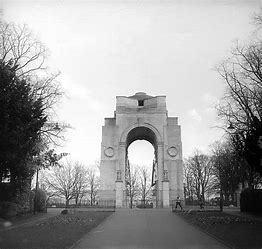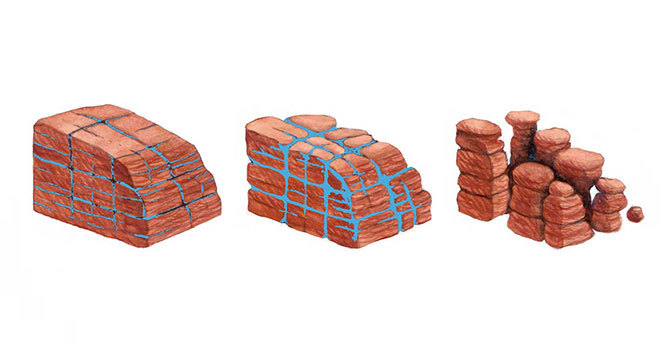Hi
About the cenotaph
- There are two war memorials on the park, the most notable of which is the magnificent memorial arch (Cenotaph) built to commemorate the dead of the First World War. A small Rock Memorial located near to the pavilion commemorates the American 82nd Airbourne division who were based in Leicester prior to the D Day landings in 1944.
- Both the Victoria Park Cenotaph and the two lodges which front onto London Road were designed by Sir Edwin Lutyens famous for designing The Cenotaph in Whitehall London.
- Leading up to the memorial arch from University Road is Peace Walk flanked by flower beds which provide a formal approach to the Cenotaph.

Geology of the cenotaph
- Sedimentary rock are types of rock that are formed by the depostion and subsequent cementation of that material at the Earth's surface and within bodies of water
- Igneous rock is formed through the solidifcation of magma or lava
- Metamorphic rock is subject to heat pressure causing physical or chemcial change.
The memorial is made from portland stone.

-
Portland stone is a limestone that dates back to the late jurassic period that is quarried on the isle of Portland in Dorset, England.. It has been used extensively as a building stone throughout the British Isles, notably in major public buildings in London such as St Pauls Cathedral and Buckingham.
-
Portland stone is sedimentary rock formed in a marine environment, usually on the floor of a shallow, warm, sub-tropical sea probably near land . When seawater is warmed by the sun, its capacity to hold dissolved gas is reduced; consequently, dissolved carbon dioxide (CO2) is released into the atmosphere as a gas. Calcium within the water is then able to combine, to form calcium carbonate (CaCO3) as a precipitate. Calcium carbonate is the principal constituent that forms most limestones.
Types of weathering
Weathering is the wearing down or breaking of rocks while they are in place. Weathering can be biological, chemical or physical.

Physical or mechanical weathering
- Physical weathering occurs when physical processes affect the rock, such as changes in temperature or when the rock is exposed to the effects of wind, rain and waves.
- Water can get into cracks in a rock and, if it freezes, the ice will expand and push the cracks apart. When the ice melts, more water can get into the larger crack; if it freezes again it expands and can make the crack even bigger, which is known as freeze thaw weathering
- Wind can cause weathering by blowing grains of sand against a rock, while rain and waves cause weathering by slowly wearing rock away over long periods of time.

Chemical weathering
- Chemical weathering describes the process of chemicals in rainwater making changes to the minerals in a rock.
- Carbon dioxide from the air is dissolved in rainwater, making it slightly acidic. A reaction can occur when the rainwater comes into contact with minerals in the rock, causing weathering.
Biological weathering
- Biological weathering is caused by the movements of plants and animals. For example, a rabbit can burrow into a crack in a rock making it bigger and eventually splitting the rock, or a plant may grow in a crack in a rock and, as its roots grow, cause the crack to widen. Even you can be a source of weathering! Boots and shoes walking over the same patch of rock may eventually wear down the rock
Staining of memorials
Many factors go into making a memorial appear different over time than it originally did when it was first put up. It is often the case that the headstones that are originally set up are subjected to algae and other bacteria that begin to turn it black with time. A few of the culprits include:
- Lichen
- Moss
- Mold
- Algae
- Mildew growth
- General stains
All of these things can combine in some cases, and it is possible that this will make the memorial turn black even faster than it otherwise might have
Human Interventions
Next we need to consider the human interventions when it comes to weathering and maintaining memorials
Cleaning
Wash, machine clean or reface
- Cleaning is most often required for porous stones such as Marble, Nabresina, Portland and York Stone as they suffer more from the effects of time and weather. Some masons choose to use a stone cleaner to ‘wash’ the memorial, this will achieve a certain standard but is not always very effective or long lasting. At Memorials of Distinction we prefer to ‘machine clean’ the stone – this involves removing a thin layer from the surface of the memorial revealing fresh stone, stone that was formed 1000’s of years ago! This technique can leave the memorial looking almost new and retains the original lettering.
- With some very old memorials however, where the lettering is not cut very deeply or the weathering is severe, machine cleaning is not suitable. The inscription would not be clear enough. Where this is the case we would suggest ‘re-facing’ the stone and re-lettering it.
Lead Lettering
- Lead filled lettering stands proud of the surface of the stone so can often be difficult to clean with a machine. To address this a combination of stone cleaner and machine cleaning can be used. Unfortunately, some stains are so deep they will never come out
About the cache
The cache is an earthcache, which means you will need to answer geological questions to log this cache as a find. These answers can be sent to me, by email or the message centre. You dont need to wait for a response from me to log as a find, but if there are logs without the corresponding email or message, then that log will be deleted without notice.
1. Why was Portland stone used to make the cenotaph? Was Weathering a factor?
2.Observe the memorial, you will see evidence of staining on the cenotaph. 2a which type of weathering and culprit primarily caused this? 2b. explain why you think this specific type of weathering and culprit is responsible? 2c. Can something be done about the staining?
3.Have a look around the Cenotaph. To what extent has some parts of the memorial weathered more or less than other parts of the memorial?
4Describe how the Portland stone will weather in the future . Explain your answer.
5. Optional task. If you would like to post a picture of yourself or your GPS at the memorial then your more the welcome too, but any spoiler photos will be deleted.
Thanks for visitng
Congrats KaosCL and BigLynx for the joint FTF.
***** PLEASE NOTE IMPORTANT *****
CACHES ARE NOT ALLOWED TO BE PLACED ON ACTUAL MEMORIALS OR WITHIN THE BOUNDARY OF SUCH
AT ALL TIMES PLEASE TREAT LOCATIONS OF MEMORIALS WITH RESPECT